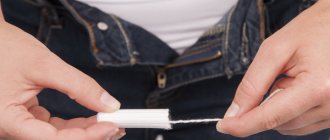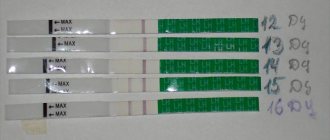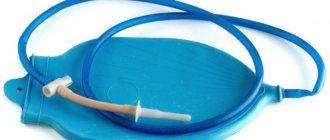There are plenty of urban legends about tampons, and you've probably already heard some bad advice about using them. Knowing the facts will dispel your fears and clear up any misunderstandings.
With pads, as a rule, everything is extremely simple - all you have to do is choose the brand and degree of absorption. The situation is completely different with tampons - these hygiene products are surrounded by numerous myths, sometimes absurd and groundless. But the most important question that worries most young girls is whether virgins can use tampons?
There is an opinion that virgins should not use tampons. This is wrong. The hymen becomes especially elastic during puberty. In addition, it has a natural opening with a diameter of about 1.5 cm, through which vaginal discharge and menstrual blood pass.
On “these” days, under the influence of estrogen, the hymen becomes more extensible, and the hole in it can increase to 2.5 cm, so small tampons, for example, such as ob mini, cannot damage it. In addition, according to research, in 90% of girls the structure of the hymen itself cannot in any way interfere with the insertion of a tampon.
mozhno-li-devochkam-devstvennicam-ispolzovat-tampony-2
What are sanitary tampons?
Modern hygienic tampons are made from natural materials that absorb moisture well. After insertion into the vagina, they begin to absorb bloody discharge and vaginal secretions. At the same time, the tampons swell and do not allow blood to “leak” out and stain underwear and clothes.
At what age can you use tampons?
This question mainly arises among young girls. They worry that early use of sanitary tampons may lead to pain or even damage to the hymen. However, gynecologists say that using tampons, provided they are correctly chosen in size and carefully inserted, can be started from the onset of a girl’s first menstruation. The procedure for inserting and removing a tampon is absolutely safe and harmless to the health of a young girl.
The hymen has a special opening through which menstrual blood is released. The size of this hole by the time menstruation begins is at least one and a half centimeters. The diameter of most tampons is even slightly smaller. Therefore, it is almost impossible to damage the hymen when using tampons.
Choosing your first tampons
The choice of hygiene products is huge, represented by products of different brands and sizes, artificial and natural materials are used in production - it is possible to evaluate the convenience and quality only from your own experience. You should not trust the opinions of others and advertising in matters affecting your own health; the same material can cause allergic reactions in consumers.
You should start with small-sized hygiene products - the packaging is marked “mini”; purchase the product at the pharmacy.
Special teenage models have been developed with a delicate coating, increased porosity to absorb secretions, and a convenient applicator. This helps beginners to master the hygiene product.
For virgins, sizes “mini” and “normal” are offered - the markings are indicated on the packaging.
“Norma” adsorbs a volume of 20 ml of blood, size 15-20 mm in length. The hymen retreats from the entrance to the vagina by 15-30 mm, the likelihood of rupture is minimal.
Popular brands:
- OB - the surface is smooth; during manufacturing, the material is laid in the shape of a spiral, which facilitates insertion. The absorbing effect is increased, the size is compact.
- The appearance is original - they open like lipstick, the shell stops the introduction of pathogenic microorganisms. Elastic, flexible, easy to use.
- The size is compact, the coating is smooth, ease of insertion is ensured by the design.
- Popularity is ensured by its properties: parameters and sizes are presented in a wide range, hypoallergenic effect, smooth surface.
Can a tampon interfere with movement or fall out?
We found out at what age you can use tampons. Now let's find the answer to another question, which also often worries teenage girls.
Discomfort from an inserted tampon can indeed occur, but only if it was not inserted correctly. Unpleasant sensations in the vagina can also occur if the diameter of the tampon is incorrectly selected. Therefore, if you plan to use tampons, it is advisable to consult a gynecologist first. The doctor will not only tell you which tampons are best to use, but will also explain in detail the procedure for inserting and removing them. In addition, there are some contraindications for using tampons.
But you should not be afraid that the tampon may spontaneously fall out of the vagina. The inserted tampon fits quite tightly to the vaginal walls. And as it becomes saturated with menstrual fluid, it swells and cannot budge on its own.
Is it possible to lose your virginity with a tampon?
Tampons are a means of hygienic protection for women during menstruation. Tampons are made 100% from natural raw materials - cotton - it is sewn, twisted and pressed, forming a physiological shape.
A tampon is inserted directly into the vagina, where it absorbs menstrual fluid into itself, preventing it from coming out. It is this fact that makes tampons so attractive to dynamic women. And it is this fact that causes the most concern among girls: will a tampon damage the hymen?
How to use tampons correctly?
Before unpacking the tampon, wash your hands thoroughly with soap and water. Try not to worry and relax your perineal muscles as much as possible. The vagina is located at a slight angle towards the lumbar region. In this regard, the tampon should be inserted in the same direction. It is very convenient to insert a tampon while sitting on a bidet or toilet, slightly tilting your body forward and spreading your legs wide apart. If you didn't manage to insert the tampon correctly the first time, don't be upset. Very quickly you will learn to do this without the slightest effort.
To remove the tampon, gently pull the pull cord. But if it suddenly breaks, don’t panic. Wash your hands thoroughly, lie down on the bed, spread your legs apart and carefully remove the tampon from the vagina with your fingers. Such situations arise extremely rarely, mainly in cases where a teenage girl begins to pull the lace with great force or makes a sharp jerk on it.
At what age can you use tampons and how to do it correctly
A girl who has only recently started menstruating is often overwhelmed by many questions: “What is a tampon?”, “How to use a tampon?”, “At what age can you use tampons?”, “How to insert a tampon correctly?” Such questions are quite natural, and someone should help deal with them.
Tampons are products that are quite easy to use, and you don’t need any supernatural skills to use them. These devices are made from lightweight natural absorbent materials. In the vagina, under the influence of moisture and blood, the tampon swells and does not allow you to “leak.”
The most common question is: “At what age can you use tampons?” - arises against the background of the fact that girls are afraid of damaging the hymen. Experts note that the use of tampons by virgins is harmless and there is absolutely nothing to be afraid of.
The fact is that in the hymen there is a hymenal opening specifically designed for menstrual flow. By the beginning of the first menstruation (at about 11-14 years), the hole has a diameter of one and a half centimeters, and the size of the tampon is approximately the same, which guarantees the preservation of the hymen intact.
It is very important to choose the right tampon for the first use. For teenage girls, it is better to choose tampons in the “normal” size, or even better, in the “mini” size. In order to insert it without extra effort, it is better to choose a tampon with an applicator.
Why can tampons get in the way?
A question that worries many teenagers is: “At what age can you use tampons?” - we have already looked at it, now it is very important to understand how to do it correctly. If you experience discomfort from a tampon, it is most likely due to improper insertion of it into the vagina.
If the tampon is inserted correctly, you will not feel its presence at all. Also, discomfort may be felt due to an incorrectly selected tampon size.
Gynecologists advise: before using tampons for the first time, consult a doctor for advice, because there may be contraindications to the use of this hygiene product.
Some girls worry that the tampon may “fall out”, and subsequently unpleasant situations may occur. In fact, these worries are unfounded, because the tampon is designed in such a way that it fits very tightly to the walls of the vagina and does not move. After some time, this hygiene product becomes saturated with menstrual fluid and swells.
How to insert a tampon correctly?
When inserting it, it is very important to thoroughly relax the muscles of the perineum and not worry - this will help resolve the issue of at what age can you use tampons. The vagina itself is naturally angled upward toward the lower back, which is why the tampon must be inserted at the same angle. It is very important to choose the right position for this procedure. One of the most comfortable poses is when one foot is on the floor and the other is on a slight elevation. You can sit on the bidet, spread your legs wide and lean forward a little.
If you were unable to insert this hygiene product correctly the first time, do not be upset; over time, you will learn to do it without much effort.
Removing the tampon is very easy: you just need to pull the special pull cord, and you're done. If a situation occurs when the cord comes off, there is nothing to worry about. You need to wash your hands thoroughly, lie down comfortably on the bed and carefully remove it by hand. To prevent this situation from happening, try not to tug on the cord again or pull it unnecessarily.
Question: “At what age can you wear tampons?” - we've looked into it. But there is another problem that worries many women. Which is better: pads or tampons? Here you need to rely only on your feelings. Gynecologists advise girls not to use tampons all the time, but only when it is absolutely necessary (in the pool, at the sea, on the beach), and the rest of the time it is better to give preference to pads.
Which is better: tampons or pads?
We've answered most of the questions teen girls have about using tampons, including the important one: "At what age can you use tampons?" But there is one more answer, which is also of interest to young girls: “What should I give preference to – pads or tampons?”
Gynecologists do not advise women, much less teenage girls, to constantly use tampons. This is due to the fact that when using them there is a risk of developing toxic-infectious shock. Therefore, use sanitary tampons in cases where it is necessary, for example, at the beach, swimming in the sea or in the pool, and the rest of the time, give your preference to pads.
Video from YouTube on the topic of the article:
Video
Modern children, just like their parents, cannot imagine their daily life without gadgets: tablets, mobile phones, laptops, TVs - they are all used daily. But in addition to the obvious benefits, electronic devices also have a negative effect on the child’s body and, above all, on vision.
Unfortunately, the number of children suffering from myopia is only increasing every year. When thinking about correcting their child’s vision, many parents, after weighing the pros and cons, come to the conclusion that the best option is lenses. But a reasonable question arises: at what age are children allowed to wear them?
At what age can children wear lenses?
Indeed, there are restrictions on wearing lenses. Using this method of vision correction too early is not recommended by ophthalmologists for the following reasons:
- The development of the cornea and the eyeball as a whole occurs in a child before he reaches the age of 14 years. Since lenses are still a foreign object, improper selection of them can affect how well the cornea will form in accordance with the norm. That is why it is important to choose suitable lenses, especially in terms of the “Radius of Curvature” indicator.
- Until the age of 14, few children are able to bear responsibility for following the rules for wearing lenses. It can be difficult for children to manage the timing of scheduled lens replacements, to carefully remove and put them on daily, and to ensure that they are cleaned and stored properly, but some can do this quite well at 10 years old if they understand the motivation.
However, lenses have a number of obvious advantages over glasses:
- Contact lenses give children freedom of action, which is very important for their normal physical and social development. If a child wears glasses, he should always be careful and careful. He cannot play outdoor games with other children because... Always remember that glasses can fall and break.
- Lenses do not limit the angle of view, unlike glasses, and also provide better contrast and brightness of the image.
- Children are very sensitive to their own appearance and are often embarrassed to wear glasses. In this case, lenses will fit better, because... they are completely invisible to others.
- Lenses, unlike glasses, cannot be lost or broken. The latter will also have to be changed as the child grows, and also depending on his preferences in terms of style.
All this allows you to make a decision in favor of wearing lenses, but their choice must be approached very responsibly.
How to choose lenses for a child?
If you decide to buy contact lenses for your child, you should not choose them based on your own discretion or based solely on price. We recommend that you contact an ophthalmologist who will select lenses after examining the degree of myopia or farsightedness of the child, the presence of astigmatism or other eye diseases.
In our company, you can get a consultation with an ophthalmologist and immediately purchase the lenses that will be recommended for your child. In addition to the obvious time savings, unlike visiting a children's clinic at your place of residence, consulting a doctor in our center has other advantages.
The doctor will tell the child how to handle the lenses, give instructions on how to remove and put them on, and the child will be able to try to carry out all the procedures on his own, under the supervision of a specialist.
The doctor will not just check the child’s vision, but will select suitable lenses depending on their characteristics. In addition to optical power, lenses differ in radius of curvature, overall diameter, and percentage of moisture content. Lenses from different manufacturers allow oxygen to pass through differently and have different levels of UV protection. Only a doctor specializing in the selection of lenses knows about the features of each brand and model, so the lenses will be selected with maximum consideration for the characteristics of the eyes of a particular child.
For the first time, while the habit of wearing lenses is just forming, you can choose daily replacement lenses for your child. They do not need to be rinsed with solution, so the child will only need to learn how to carefully put on and remove the lenses. In addition, such lenses are more hygienic, because... Every day the child will put on a new pair of lenses.
The development of conjunctivitis or blepharitis, which can occur due to improper cleaning of lenses designed for a longer period of wear, is reduced to zero here. When the child is already accustomed to wearing lenses, it will be possible to choose bi-weekly or monthly replacement lenses.
Correct selection of lenses and compliance with the rules for wearing them is the key to the health of a child’s eyes. If these conditions are met, you can start wearing lenses before you reach 14 years of age. In our company you can purchase lenses from the world's leading manufacturers and everything you need to care for them and receive the necessary consultations from an ophthalmologist.
You can select contact lenses using the free “Beginner” program, which includes an vision test, selection of contact lenses, training in wearing and the first contact lenses for free!
To complete the “Beginner” program, children under 18 years of age must have a recent report from an ophthalmologist. You can undergo an examination by a pediatric ophthalmologist at the addresses indicated or at the clinic at your place of residence.
Malocclusion or crooked teeth are a fairly common problem that can be solved with braces. But many are tormented by the question: at what age can you get braces? It is asked by parents who want their child to have straight teeth, and by adults who decide to solve their bite problems.
Yes, orthodontic appliances are worn not only by children, but also by teenagers and many adults. They have proven themselves to be an excellent option for correcting dental defects.
If a child has an incorrect bite, curvature of the dentition, incorrect placement of teeth on the jaw, their protrusion forward, as well as noticeable gaps between the teeth, then it is better not to postpone the use of braces.
Treatment should also be used when the parents have a history of malocclusion. According to some experts, problems with bite can appear in cases where a child has problems with the spine or posture, and also has habits such as constant thumb or pacifier sucking at a very young age.
There are contraindications for installing braces. These include infectious and inflammatory processes in the oral cavity, poor dental condition, the presence of caries and dental plaque, gum inflammation, and cancer. The use of braces for diseases of the cardiovascular, endocrine, and skeletal systems is strictly prohibited. These devices should not be used by persons who have a mental disorder or are undergoing treatment for drug or alcohol addiction.
In any case, the decision to correct the dentition is made by the orthodontist after a complete diagnosis. You also need to remember that when braces are placed, all teeth must first be treated.
Effect of age for adults
Many people decide to wear braces at an adult age, when their teeth have long been formed. They ask at what age do you have to get braces? For example, having decided to correct the dentition after 30 years, you need to know about some nuances.
Age practically does not matter, the main thing is that the teeth are in good condition. The correction process in this period of life cannot happen quickly and requires even more time, since bone tissue growth ends at 25 years.
Dmitry Sidorov
Orthopedic dentist
This is why it is better to get braces before reaching 25 years of age. This will definitely shorten the period of wearing them.
Sometimes, to achieve good results, doctors recommend removing one or another tooth. This is required because at the age of 30 and older, there is no longer free space in the oral cavity for the ideal arrangement of teeth. In this regard, doctors resort to this procedure in order to provide maximum conditions for the formation of a beautiful bite.
Braces are not suitable for adults. Orthodontists often recommend installing metal appliances, as they are more durable and provide minimal wearing time. However, many adults refuse metal braces, choosing ceramic braces to maintain the aesthetics of their appearance. Sometimes you can see sapphire devices in adults, but they have a rather fragile structure and significantly slow down the correction period.
Dmitry Sidorov
Orthopedic dentist
What can you eat if you have to wear braces? Anything except solid food, which can have a strong physical impact on the system and damage it. For example, it is not recommended to eat whole apples.
The most popular are lingual models, which differ from others in the way they are attached. It’s difficult to say at what age such systems are installed, but adults use them with great enthusiasm, since they are installed on the inside of the teeth and are practically invisible to others. This way, you can completely hide the fact that you are correcting your teeth. The main condition for the use of lingual structures is sufficient height of the teeth.
Dmitry Sidorov
Orthopedic dentist
Until how old you can get braces, the orthodontist decides individually. There are no specific age restrictions: everything depends on the patient’s health condition.
For minor defects, adults (children too) are recommended to install aligners. Modern products are made of silicone or polyurethane. are used in simple cases, and polyurethane devices in more complex ones. The aligners are practically invisible to others and also do an excellent job with. The length of time they are worn depends on the age and condition of the defect.











